With diverse foliage textures and colors, these Best Ferns for Containers provide interest in shady spaces!
Looking for attractive foliar specimens to liven the dull corners of your house with minimal effort? These Best Ferns for Containers will help you with just that! All they need are moist soil, regular watering, and dappled shade. These shade-loving plants can be grown alone or mixed with other plants in various container combinations.
Best Ferns for Containers that Grow Indoors & Outdoors Easily
1. Lady Fern
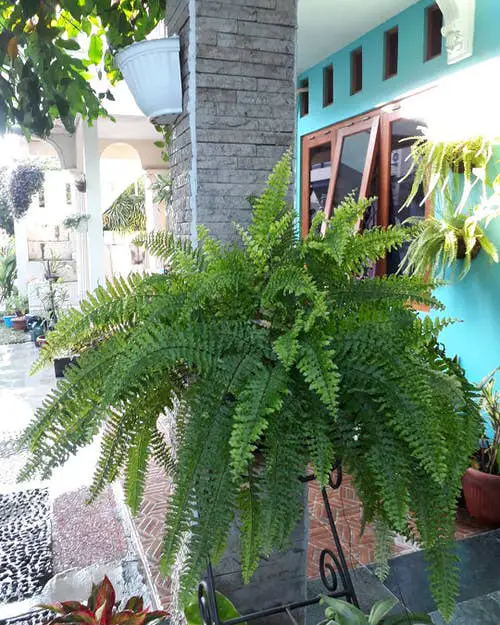
Botanical Name: Athyrium filix-femina
USDA Zones: 3 – 10
A finely textured ornamental foliage plant that you can grow in containers easily. If you live in cooler zones, expose the Lady Fern to dappled sunlight, maintain a moist medium, and pick a small to medium-sized pot for the best growth.
Pair it with flowering plants in warmer colors (yellow, red, and orange), and you will have an attractive container arrangement for indoors.
2. Shaggy Shield Fern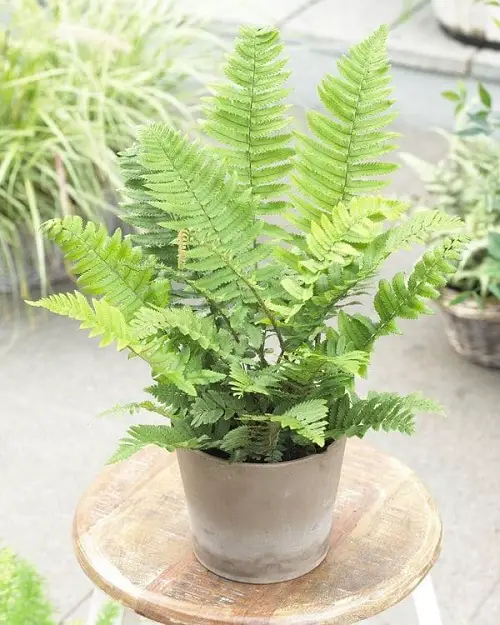
Botanical Name: Dryopteris cycadina
USDA Zones: 5a – 8b
Looking for a versatile option that thrives both indoors and outdoors? Shaggy Shield Fern is the one! Also called the Black Wood Fern, this evergreen fern sports medium-sized clumps of mild green, lacy fronds borne on dark stems. With an arching habit and a stiff appearance, the Shield Fern does a good job of offsetting the bright colors of the interiors.
Use it in conjunction with other shade-loving plants, such as Hostas. Grow this plant in a partially shaded spot, in an average-sized container, using moist, well-drained potting soil.
3. Scaly Male Fern
Botanical Name: Dryopteris affinis
USDA Zones: 4 – 10
With vibrant green fronds and dark pinnae, this versatile fern catches everyone’s eye. It grows best in cool temperatures and adopts a compact, petite form (up to 2 feet tall) that makes it an excellent choice for containers.
While it can tolerate some sun and the wind, choose a cool and shady spot for growing Scaly Male Fern in hot climates.
4. Sunset Fern
Botanical Name: Dryopteris erythrosora
USDA Zones: 6 – 9 but can be grown in USDA Zones 10, 11 with some care
Native to the Himalayas, India, and Western China, the Sunset Fern is a beautiful foliage plant with delicate, arching fronds that appear coppery-red at first and turn a beautiful green when mature. This lovely transition earns the plant its name.
Plant it with Epimediums and Jack Frost for an eye-catching burst of colors.
5. Hay Scented Fern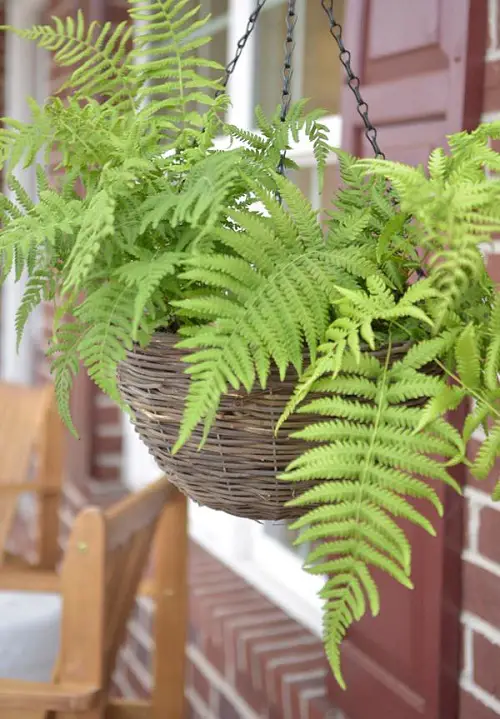
Botanical Name: Dennstaedtia punctilobula
USDA Zones: 4 – 9
The Hay-Scented Fern is so named because it has the typical fragrance of hay, especially at the end of the growing season when the fronds are developing a rusty-brown color. In fall, the fronds adopt an orange hue, providing a stunning background to ordinary green plants. It grows up to 1 – 3 feet tall and is definitely among the Best Ferns for Containers indoors and outdoors.
An 8-10 inches deep pot is sufficient for its growth. Keep the plant in partial sun and water regularly to maintain consistent moisture.
6. Dallas Fern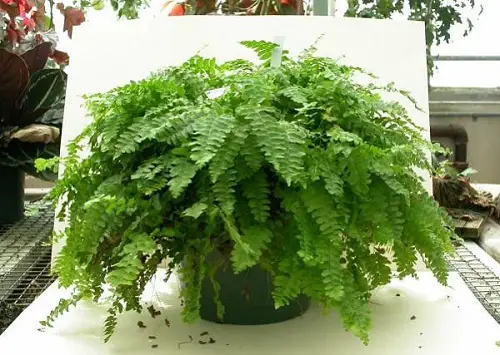
Botanical Name: Nephrolepis exaltata ‘Dallas’
USDA Zones: 8 – 11
The Dallas Fern is a heat-loving and compact fern that flaunts short fronds with a frilly appearance and is highly cherished among outdoor ferns. One of the most attractive features of the plant is its dense foliage, which makes it look like a bouquet.
Dallas Fern is a nice choice for busy apartment dwellers who lack time to tend to their thirsty houseplants.
7. Kimberley Queen Fern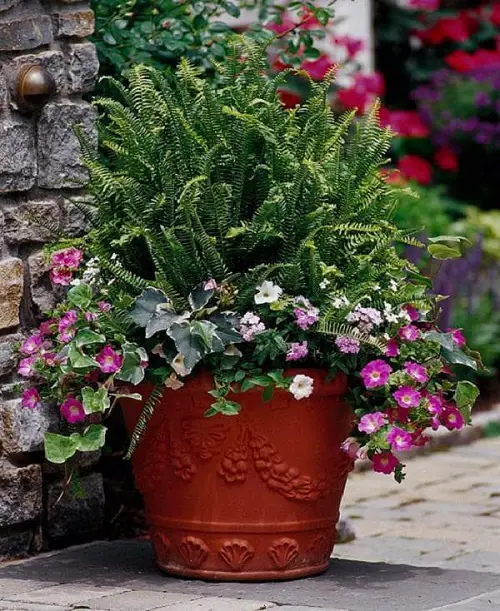
Botanical Name: Nephrolepis obliterata
USDA Zones: 9 – 11
Originating from Australia, this elegant fern flaunts upright, deep-green fronds that retain their form in wind and hail. While it prefers shade, it does well if exposed to full sun for some time, as long as it gets regular water.
A vigorous and highly adaptable grower, this versatile fern is a great choice for growing in both containers as a houseplant and as an outdoor addition.
8. Macho Fern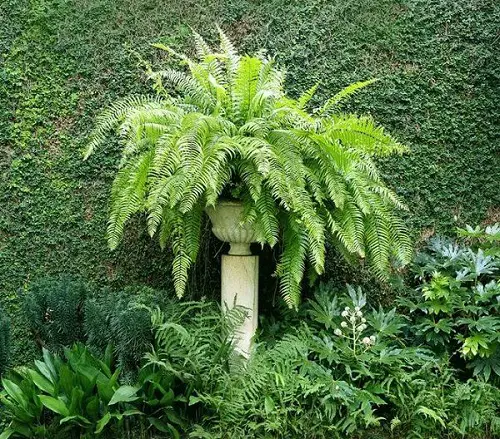
Botanical Name: Nephrolepis biserrata ‘Macho’
USDA Zones: 9 – 11
Growing Macho Fern outdoors is easy in warm subtropical or tropical regions as it tops the list of potted ferns. You can grow it in containers and urns outdoors on patios, porches, front doors, or indoors. This fern can reach up to 4-6 feet high, so choose a large container. Trim off old fronds to trigger new growth and keep the nascent ones protected from the direct sun.
Place the pot in a spot that receives a few hours of the morning sun, away from drying winds. Keep the soil moist, and fertilize a couple of times during the growing season.
9. Tiger Fern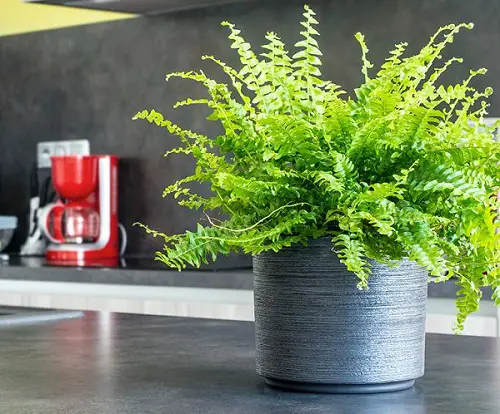
Botanical Name: Nephrolepis exaltata ‘Tiger Fern’
USDA Zones: 9 – 11
Searching for a unique one in the list of the Best Ferns for Containers? Brilliant green leaflets with metallic stripes make the Tiger Fern a true conversation starter. This plant is a quick grower and works well either solo or as a companion houseplant in baskets and containers.
Display your Tiger fern in a shaded spot like a porch or a balcony. Proper drainage is crucial too, or this plant will end up wilting.
10. Autumn Fern
Botanical Name: Dryopteris erythrosora
USDA Zones: 5 – 11
Valued for its coppery-red leaves that offer beauty throughout the growing season, the Autumn Fern’s fronds are long and slender and add a lacy finish to a woodland setting.
Its short height (up to 2 feet) and preference for deep shade make it one of the best ferns to grow in containers on a shady spot. Team it up with Hostas for a blond touch.
11. Hart’s Tongue Fern
Botanical Name: Asplenium scolopendrium
USDA Zones: 4 – 10
One of the best evergreen ferns for containers, it bears unique tongue-shaped leaves with pointed ends. The Hart’s Tongue fern grows well in shaded areas, and it’s often seen covering large areas underneath trees and rocks or alongside streams, where its upright fronds form a striking contrast with the rounded shapes of damp-loving flowers.
It is a popular choice for a shade garden. Use it as a focal point or as a filler in your container combinations.
12. Western Sword Fern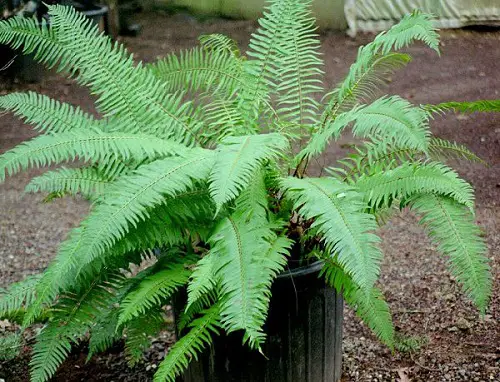
Botanical Name: Polystichum munitum
USDA Zones: 4 – 9
This maintenance-free fern is known for its green, sword-shaped fronds that form a lush, evergreen ground cover in the forests of the North-Western US. The Western Sword Fern benefits from the partial shade, well-drained soil, and occasional trimming and is a low-maintenance choice among the Best Ferns for Containers list.
This hardy native fern can also be grown as a centerpiece in planters in warm and arid regions.
13. Boston Fern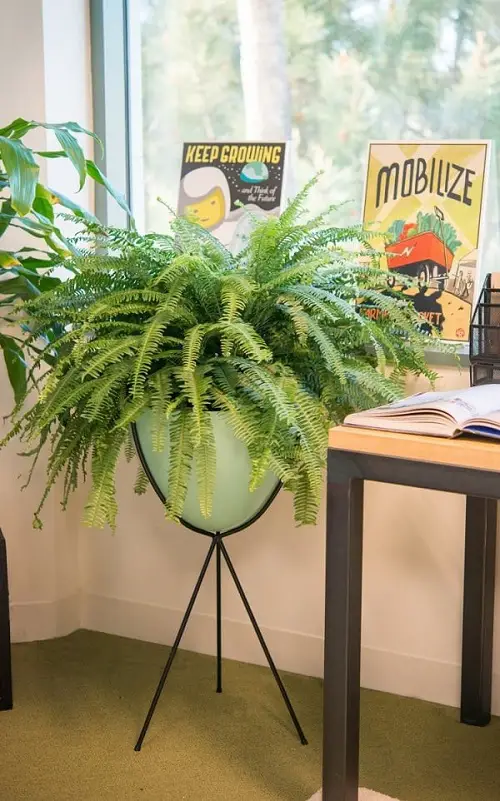
Botanical Name: Nephrolepis exaltata
USDA Zones: 8 – 11
A close relative of the sword fern, this elegant, old-fashioned plant is valued for its leathery, kelly-green foliage that makes it a stunning potted fern. With its ruffled leaves and gracefully arching fronds, it’s easy to see why it’s so admired worldwide. Best suited for warm climates, growing Boston fern outdoors is a walk in the park.
Boston Fern makes a nice outdoor container choice for spring and autumn in cooler regions. Growing Boston Fern indoors is also easy. It grows up to 2-and-half feet tall and prefers well-drained soil, making it an excellent choice among potted ferns.
14. New Zealand Tree Fern (Wheki Fern)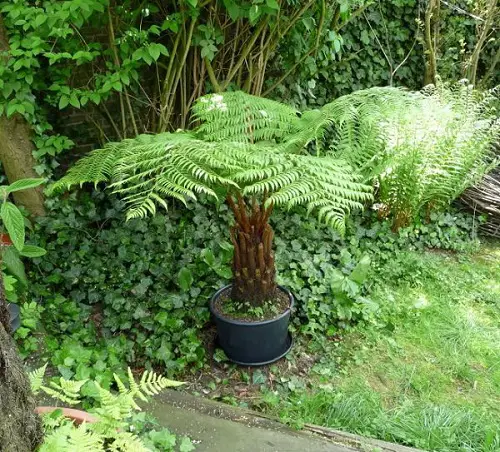
Botanical Name: Cyathea dealbata
USDA Zones: 8 – 11
The New Zealand tree fern is similar to its cousin Dicksonia Antarctica. Like other ferns, it is a slow-growing plant with lush fronds spread above a thick trunk. For optimal growth, it prefers a shady environment. Its almost black trunk complements the fine, bright green foliage.
It can grow up to 20 feet tall in the wild but around 5 feet in a container. So choose a large pot and keep it in a spot that receives partial sun and minimal wind. It’s not very cold-hardy and requires moderate temperatures to thrive.
15. Japanese Painted Fern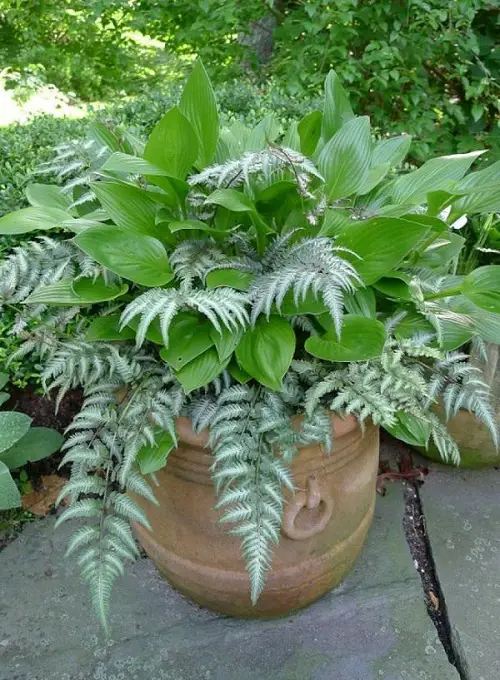
Botanical Name: Athyrium niponicum
USDA Zones: 5 – 9
As one of the best-potted ferns, it stands out from the regular green shades of common ferns with its gorgeous, silvery foliage. The fronds have an exotic airbrushed appearance with metallic markings and brilliant garnet-colored veins that really steal the show. It prefers the morning sun and light shade throughout the day.
Looking for ferns for the garden that you can pair up with beautiful foliage? Try teaming one of the Best Ferns for Containers with bold burgundy begonias, coral bells, and a bleeding heart to add interest to your shade garden.
16. Soft Shield Fern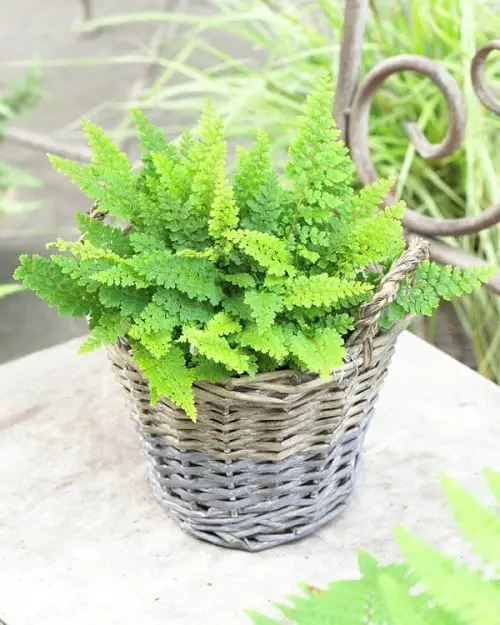
Botanical Name: Polystichum setiferum
USDA Zones: 5 – 9
Native to southwestern Europe, this tufted evergreen fern grows up to 2 – 3 feet tall and develops rosettes of feathery, spear-shaped fronds that look wonderful in a woodland setup. This plant likes the cool atmosphere and rich and moist soil.
Plant it in a pot and place it on your patio to create a seamless transition from a more formal portion of your home to the wilderness.
17. Holly Fern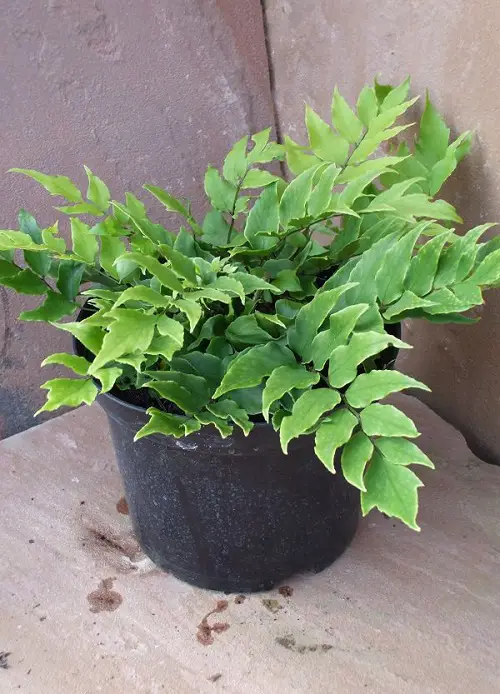
Botanical Name: Cyrtomium falcatum
USDA Zones: 6 – 11
The Holly fern can be an elegant addition to your Best Ferns for Containers collection and is popular for its heat tolerance and shiny green foliage. It has been named for its holly-like leaves and is usually grown to provide a lush green contrast to more colorful annuals and perennials.
And while it doesn’t tolerate very low temperatures, holly fern does thrive in moderately harsh winters and prefers warm climates.
18. Maidenhair Fern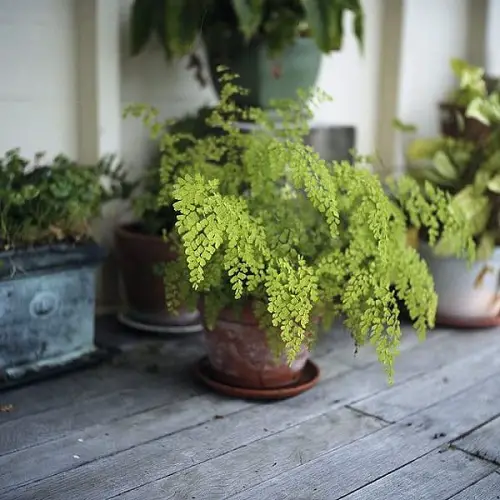
Botanical Name: Adiantum pedatum
USDA Zones: 3 – 11
Another of the best-potted ferns for containers, native to North America, it’s known for its unique light green foliage. This fern grows best in moist, lightly shaded areas with good air circulation. Maidenhair Fern is a versatile choice among potted ferns and can be grown both outdoors and indoors with some care.
Grow it in showy planters in dappled shade for an attractive display.
19. Korean Rock Fern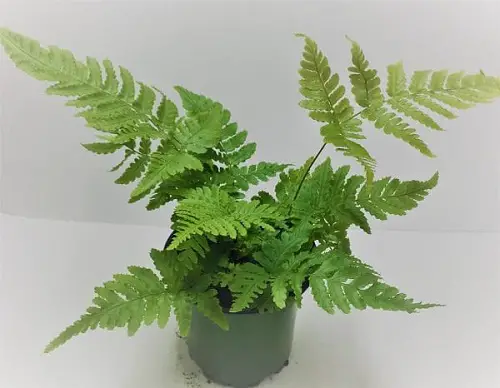
Botanical Name: Polystichum luctuosum
USDA Zones: 7 – 10
A versatile and trouble-free evergreen plant, the Korean Rock Fern forms low clumps of leathery green fronds with dark veins that form a striking show. New leaves have a purplish cast and form a dramatic contrast with the green background. Perfect for growing in borders or a shade garden, the Korean Rock Fern is best grown as a container plant in cold regions.
It also tolerates heat and humidity well and stays fresh as long you provide it with well-drained soil and regular watering, making it a popular choice among patio ferns.
20. Royal Fern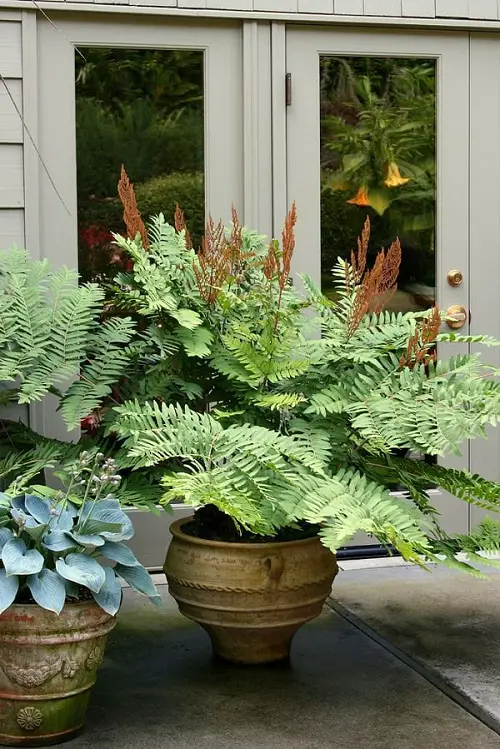
Botanical Name: Osmunda regalis
USDA Zones: 3 – 10
The Royal fern is a hardy, deciduous fern that forms large rosettes of glossy green fronds, earning it a place among the best ferns for the garden. They develop a pinkish hue in spring and are crowned with copper-brown flower spikes that have given them the name “Flowering Fern.” The gorgeous foliage turns into an amazing rusty-brown shade in fall.
Low-maintenance and disease-resistance, Royal Fern is a nice asset for shady beds, cottage gardens, and hanging baskets. You can grow this fern in a pot with ease.
21. Asparagus Fern (Foxtail Fern)
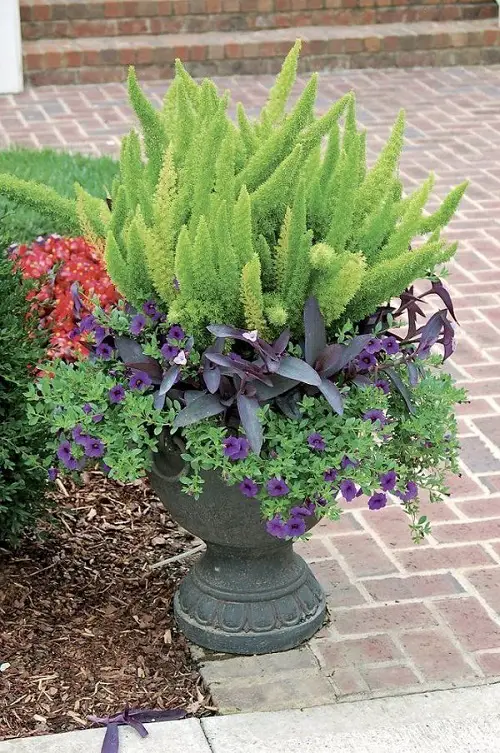 Botanical Name: Asparagus setaceus
Botanical Name: Asparagus setaceus
USDA Zones: 9 – 11
Asparagus Fern is not a true fern, actually. This fern-like plant has arching plumes of tightly packed, needle-like leaves that look soft and delicate.
It can be grown indoors as a houseplant or in containers outside in cooler zones. Whereas in hot climates, it is perennial.
22. Staghorn Fern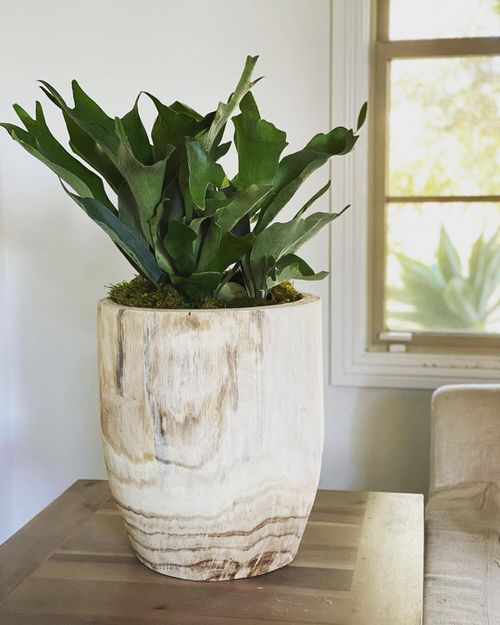
Botanical Name: Platycerium
USDA Zones: 9 – 12
The Staghorn Fern is an epiphytic plant, meaning it typically grows on other surfaces like trees or rocks. Its fronds are thick and leathery, with a beautiful green color. This fern is a fascinating addition to any garden or indoor space. It requires a warm and humid environment, making it ideal for tropical or subtropical regions.
Staghorn Ferns are often mounted on boards or hung in baskets to mimic their natural growth habit. With proper care, they can become a stunning focal point in any landscape or interior setting.
23. Silver Lace Fern
Botanical Name: Pteris ensiformis
USDA Zones: 9a – 11
The fronds of the Silver Lace Fern have a finely cut appearance, resembling intricate lace patterns, making it a favorite among the Best Ferns for Containers. It adds an elegant touch to gardens, borders, and even hanging baskets. This fern is low-maintenance and can tolerate different light conditions, from partial shade to filtered sunlight.
Searching for fern plants for indoors? The Silver Lace Fern is a beautiful choice for adding texture and visual interest to any home. It prefers well-draining soil and regular watering to keep its foliage fresh and vibrant.
24. Button Fern
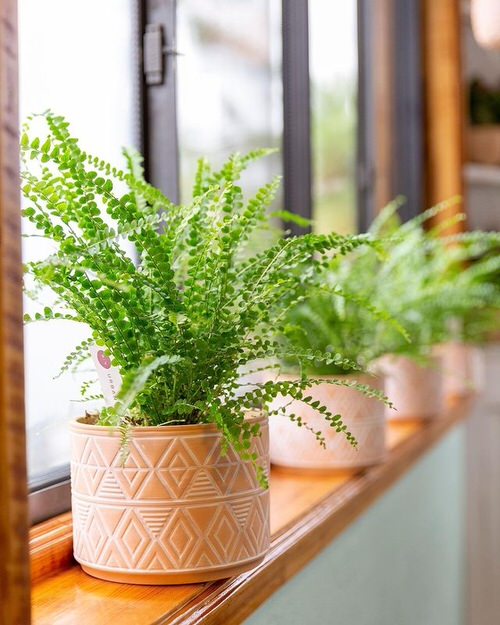
Botanical Name: Pellaea rotundifolia
USDA Zones: 9 – 11
The Button Fern adds a touch of whimsy and texture to any garden or indoor space. It prefers partial shade and well-draining soil. This fern is relatively compact in size, making it suitable for containers, rock gardens, or small spaces. This fern gets its name from its unique foliage, which consists of round, button-like leaflets attached to wiry black stems.
With its attractive foliage and easy-to-care-for nature, the Button Fern is a popular choice among fern enthusiasts.
25. Kangaroo Paw Fern
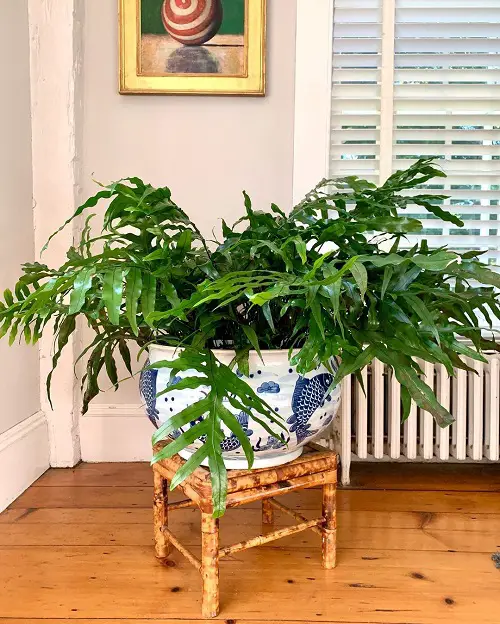
Botanical Name: Phymatosorus diversifolius
USDA Zones: 9 – 11
The Kangaroo Paw Fern has vibrant green foliage with a textured surface that adds interest to any garden or indoor space. With its striking appearance and ability to tolerate a range of conditions, the Kangaroo Paw Fern is a popular choice for adding a touch of exotic beauty to landscapes and container gardens.
Preferring partial shade and well-drained soil, the Kangaroo Fern is a low-maintenance fern for indoors and outdoors.
26. Leatherleaf Fern

Botanical Name: Rumohra adiantiformis
USDA Zones: 8a – 11b
This fern is admired for its leathery, dark green fronds that have a glossy appearance. The foliage of the Leatherleaf Fern is finely textured and can grow in a spreading, arching manner. It adds an elegant touch to shady areas, borders, and woodland gardens.
The Leatherleaf Fern is a reliable choice for adding texture and depth, but it needs partial shade and regular watering to maintain its lush appearance.
27. Japanese Tassel Fern

Botanical Name: Polystichum polyblepharum
USDA Zones: 6 – 8
The fronds of this fern have a tassel-like appearance at their tips, adding a touch of elegance to the plant and earning it a place in the Best Ferns for Containers list. The Japanese Tassel Fern is well-suited for shady areas, woodland gardens, and borders. It prefers moist, well-drained soil and can tolerate cold temperatures, making it a versatile choice.
With its attractive foliage and ability to withstand various conditions, the Japanese Tassel Fern is a popular choice among container gardeners.
28. Australian Tree Fern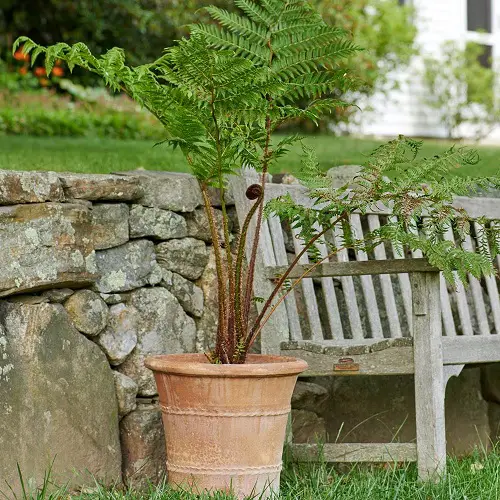
Botanical Name: Sphaeropteris cooperi
USDA Zones: 9 – 11
If you’re looking for fern plants indoors, this fern is a fantastic choice as it creates a tropical or rainforest-like ambiance in gardens and landscapes. With its impressive size and elegant fronds, the Australian Tree Fern is sure to make a dramatic statement wherever it is planted.
When growing the Australian Tree Fern in pot, make sure you choose well-drained soil enriched with organic matter.
29. Bird’s Nest Fern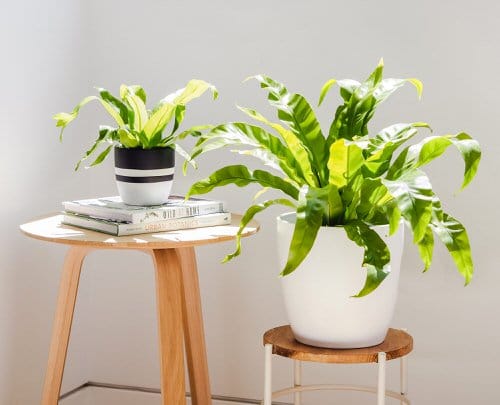
Botanical Name: Asplenium nidus
USDA Zones: 11 – 12
This fern gets its name from the way its fronds grow in a circular rosette pattern, resembling a bird’s nest. The Bird’s Nest Fern is well-adapted to growing in shady areas and is often used as a natural accent or focal point in gardens or indoor spaces.
With its unique growth habit and stunning appearance, the Bird’s Nest Fern adds a touch of tropical vibe indoors and outdoors.
30. Rabbit’s Foot Fern
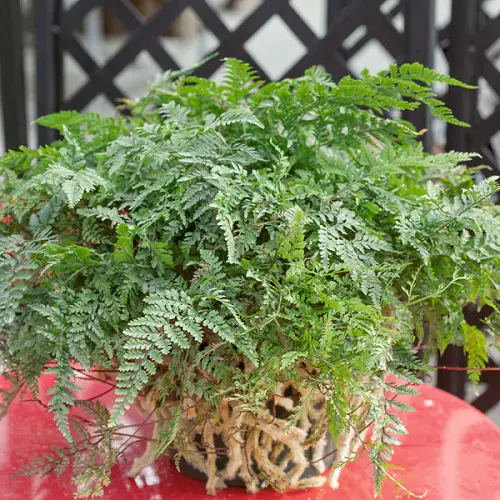
Botanical Name: Phlebodium aureum
USDA Zones: 10 – 11
The foliage of the Rabbit’s Foot Fern consists of finely divided fronds that have a silvery-green color. It adds a delicate and airy texture to gardens, hanging baskets, terrariums, and especially containers.
This fern prefers indirect or filtered light and well-draining soil, so you should place it near a north-facing window or in a bright, shaded area.



Which ferns can be left outdoors through the winter in Zone 4?
Love Ferns. I have about 12 different types of ferns in total over 50 plants. I’m in zone 9